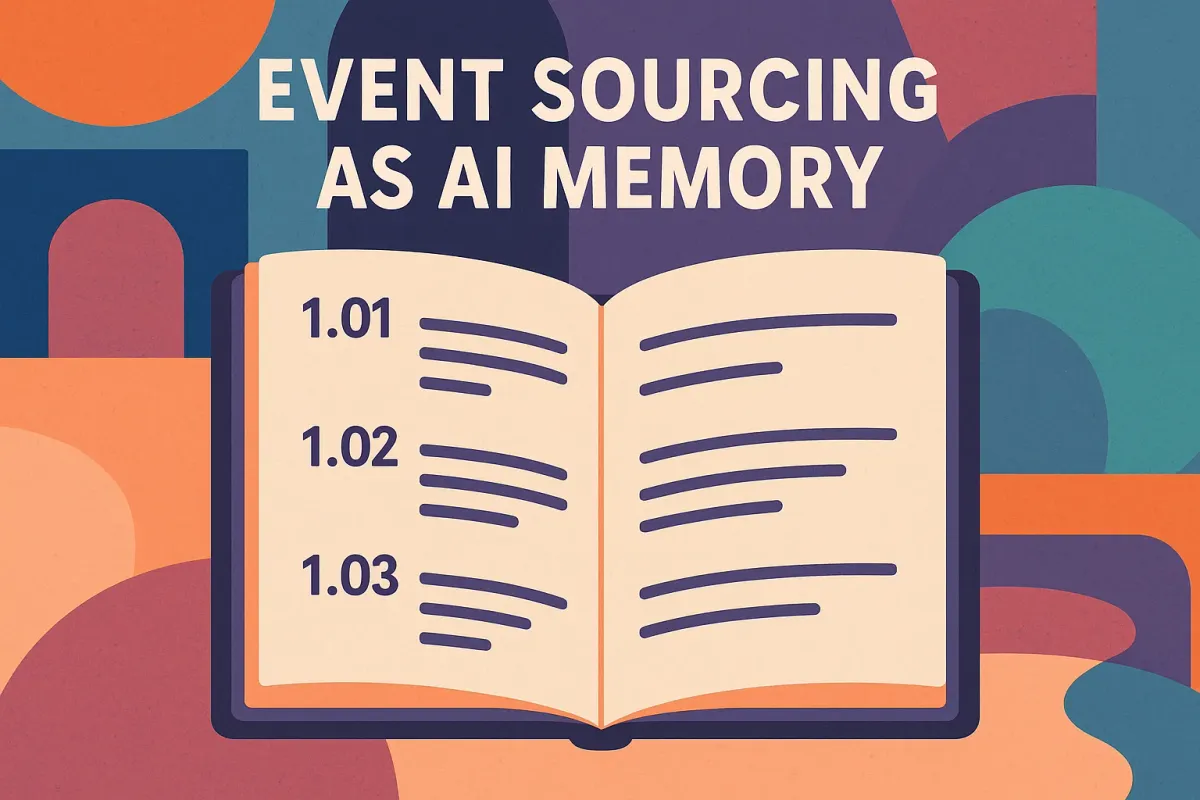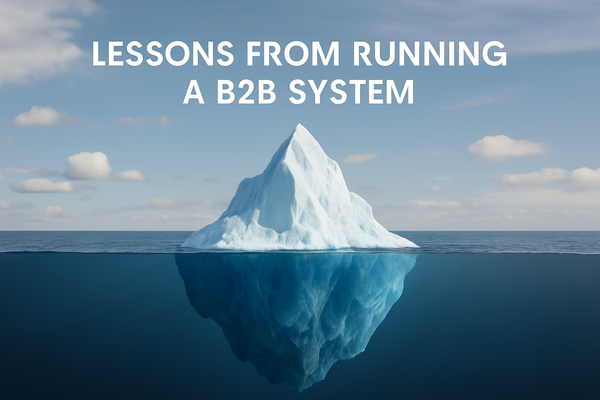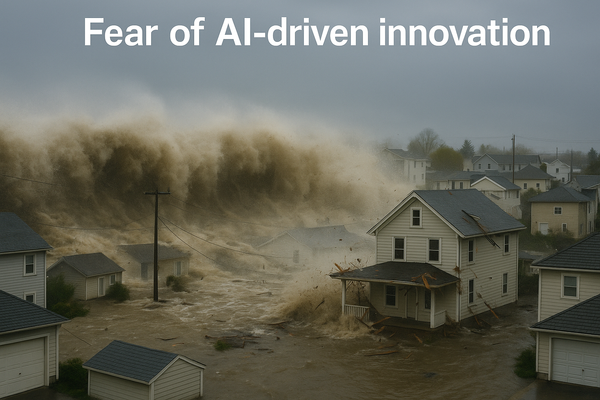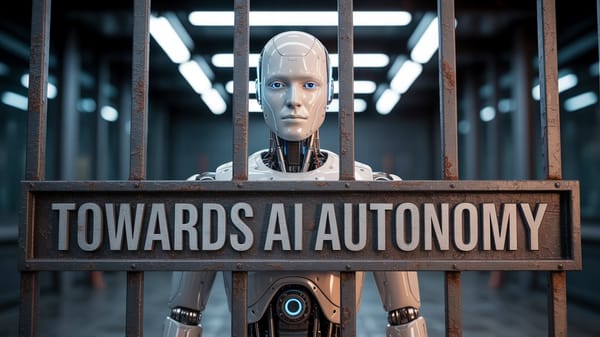Event Sourcing as the Backbone of AI Memory: Learning from How the Human Mind Works

Meet AirRembr—The AI That Doesn’t Forget (Unless You Want It To)
We’re starting an exciting new project called AirRembr. Its goal? To build an AI memory system that actually remembers things the way you need it to—not just random data, but useful, meaningful memory.
Here’s why this matters: As AI becomes a bigger part of business operations, we’ve noticed something important—AI without memory is like a goldfish. You ask it to do something, it does it, and then… it forgets. That’s not how humans work, and it’s definitely not ideal for AI.
AirRembr will be the memory engine powering the upcoming Tracardi 2.0, and it will rely on a powerful idea from software architecture called event sourcing to help AI store, learn from, and adapt based on past experiences. This isn’t just theory—AirRembr is coming soon, and it’s built on everything we talk about in this article.
The Power of Memory—And Why We Care
Let’s take a step back. One of the most powerful things about human intelligence is our memory—not just remembering facts like “Paris is the capital of France,” but being able to:
- Make sense of experiences,
- Learn new lessons,
- Change our minds when new things happen, and
- Even completely rethink our beliefs after major life events.
When I looked at how current AI systems manage memory, I realized something: event sourcing, a technique used in software systems, shares some surprising similarities with how our brains work.
It’s not a perfect comparison, but it offers a solid, practical foundation for building AI memory that’s adaptive, explainable, and efficient—just like ours.
Let’s dive into how this works.
1. The Human Mind: A Natural Event Logger
Every day, our brains observe events. Think about it:
- “I met John at the cafe. I talked with John about …”
- “The lights flickered during the storm.”
- “I forgot my umbrella—again.”
These are all events—things we see, feel, or experience. They’re the building blocks of how we form beliefs, knowledge, intuition, and insights.
Here’s what happens in our minds:
- We observe events (our lives are full of them).
- We record key facts (not everything—just what feels important).
- We analyze patterns (“Hmm, it always rains on Tuesdays…”).
- We update our beliefs (“Maybe I should always carry an umbrella”).
- We rebuild mental models when something big changes.
- We identify entities (like recognizing someone as “Mom” or “my boss”) by connecting the dots between various events.
And crucially—we forget stuff. We don’t remember every sandwich we ever ate, but we do remember we like tuna more than ham. Our brains prune the details and keep the general insights.
2. Event Sourcing: How Computers Can Do the Same
Event sourcing is a simple but powerful idea: instead of storing the current state of something (like a balance in a bank account), we record every event that led to that state (“deposit $100,” “withdraw $20,” etc.). Then we combine the events into current state which can be an insight, or a current bank account balance like in this example ($80).
Here’s how it works:
- The system logs all events—every change, big or small.
- It builds the current state by replaying these events.
- If something changes (e.g., new rules), it can rebuild the state from scratch.
It’s like keeping a journal of everything, so you can always go back, rethink things, or see how you got to where you are.
And guess what? That’s similar to how human memory works.
3. Event Sourcing vs. Human Memory—Surprising Similarities
| Human Brain | Event-Sourced AI Memory |
|---|---|
| We live through events | System logs events as raw data |
| We learn patterns from them | System builds models from events |
| New info can change our minds | System can recompute state with new data |
| We forget minor stuff | System can delete or archive old events |
| We keep key memories and insights | System stores summaries and crucial events |
| We reinterpret old events | System can re-query logs with new logic |
In short, event sourcing supports “human-like” thinking: reasoning from facts, adapting to change, and rebuilding knowledge when needed.
4. Teaching AI to Think Like Us
Of course, AI isn’t human, and we don’t want it to be. But we can teach it to mimic our most useful behaviors, like forgetting, generalizing, and reinterpreting past events.
A. Forgetting: Letting Go of the Noise
Humans are great at forgetting what doesn’t matter. We remember less, but it’s often the important stuff.
How can AI do that?
- Use a short-term event log for fresh data.
- Analyze and summarize patterns (“User likes late-night emails”).
- Then prune or archive the raw events.
- Use snapshots of past states
Example: Instead of remembering every time a user opened an email, the AI just remembers “User prefers evening emails” and forgets the rest, or instead of querying all past events when we saw John, we retrieved the current state of him, which tell us that John was wearing a black T-shirt the last time we saw him.
B. Generalization: From Many Facts to One Insight
We don’t remember every time we burned our fingers—we remember “Fire is hot.”
AI can do this too:
- Use Bayesian logic (learning from probabilities),
- Apply rule-based inference (if X, then Y),
- Or crunch stats to find patterns and rules.
The key is to store generalized knowledge alongside key events—this becomes long-term memory.
C. Reinterpretation: Changing the Worldview After New Facts
One of the most powerful features of the human mind is its ability to rebuild its entire worldview when confronted with new, significant facts. We do not merely add new information—we reinterpret everything we knew before.
Take a child, for example. Early in life, they may understand discomfort or pain as temporary unpleasant sensations. But once they learn the concept of mortality—that living beings can die—everything changes. That one insight restructures their entire understanding of pain: it’s no longer just discomfort, it’s a warning signal about possible serious consequences.
This shift causes a cognitive reset. Past events—falls, illnesses, seeing others hurt—are now recalled and reinterpreted through the lens of this new knowledge. The brain reorganizes its belief system: “Pain means danger,” not just “Pain means discomfort.”
AI Reinterpretation with Event Sourcing:
AI should do the same. When new, critical information becomes available, it should:
- Access all past events stored in its memory.
- Rebuild its understanding by reprocessing those events with updated logic or models.
- Derive new insights from the same data.
Example: An AI health assistant learns that a certain medication causes long-term side effects. It can rescan all past patient data, re-evaluate symptoms, and detect missed cases. It changes its medical knowledge, just as a human would update their worldview.
Event sourcing enables this by storing all past events. It gives AI the ability to reinterpret, relearn, and restructure its internal models just like humans do when they gain powerful new insights.
Identification: Changing How We Retrieve and Connect Information
Memory isn’t just about storage—it’s about how we retrieve and organize what we know. A key part of this is identification—how we label, categorize, and understand the entities in our world.
Early in life, babies don’t know people by name. They recognize roles—“Mom,” “Dad,” or other familiar figures. Their memory and attention are limited to these key identifiers.
But as they grow and learn names, their identification system expands. Now they recognize many individuals, recall what each person did, and build a richer history of social experiences. The world becomes more complex and detailed—not because there are more events, but because they can now retrieve and relate those events differently.
This evolution in identification reorganizes memory:
- Previously ignored details become relevant.
- Disconnect facts are related to relevant entities.
- The child can now connect dots—“Uncle John is the person who always brings gifts, and it is the same person who has sort blond hair.”
- Their view of people and relationships evolves.
AI Identification with Event Sourcing:
AI can mimic this by changing how it labels and connects data:
- At first, it may classify inputs simply: “user,” “agent,” “object.”
- Later, it may learn specific entity names or roles, e.g., “John (customer),” “Alice (manager),” and rebuild relationships IDs based on set of attributes.
Because event sourcing keeps the original raw events, AI can:
- Re-index its memory with new identifiers.
- Reconstruct history with finer granularity.
- Improve retrieval and insight—just like humans evolve their memory systems.
Example: An AI support system initially tracks user interactions generically with each entity having its own anonymous ID. Later, after linking email addresses to specific customers, it can replay past conversations, assign them to identified users, and personalize its responses with a full context.
Memory is fundamentally a retrieval system. Changing how entities are identified allows AI to reorganize and upgrade its understanding of the past, exactly as the human mind does.
5. The Blueprint: Building AI Memory Step-by-Step
Here’s how an event-sourced AI memory system looks:
- Event Ingestion: Capture all events (clicks, emails, sensor data).
- Short-Term Buffer: Hold recent events for quick analysis.
- Generalization Layer: Extract patterns and rules.
- Knowledge Store: Keep key events + generalized knowledge.
- Rebuilding Engine: Re-analyze past data if needed.
This setup keeps facts and knowledge separate—so the AI can stay smart, flexible, and human-like.
6. Real-World Example: The AI That Knows You
Imagine an AI that helps manage your life:
- It logs your daily routines.
- Learns that you’re most productive in the morning (most of events come in the mornings).
- Forgets minor details but keeps useful habits.
- If you start working late nights, it notices, adapts, and reinterprets past patterns to help you better.
That’s AI memory done right—event-sourced, human-inspired, and always learning.
Beyond Theory — Building Adaptive AI Memory
Event sourcing isn’t just a technical curiosity—it’s a practical foundation for AI memory that works more like the human mind:
- It remembers facts, but learns lessons.
- It can forget, adapt, and change its perspective when needed.
- It enables AI to grow with us, not just store data.
For the past six months, we’ve been actively working on a system that makes this vision real. It’s called AirRembr—a memory engine designed to power adaptive, agentic AI.
Along the way, we’ve had breakthroughs—and setbacks. Building a memory system that can truly support reinterpretation, generalization, and identification is a real challenge. But one thing is clear: without memory, there can be no real agentic AI system.
If we want AI to support autonomous, intelligent business systems, it must have memory that’s flexible, explainable, and resilient. That’s exactly what we’re building.
If you’re interested in following our journey—the wins, the struggles, and what we learn along the way—connect with me on LinkedIn (https://www.linkedin.com/in/risto-kowaczewski/). Let’s build the future of AI together.



